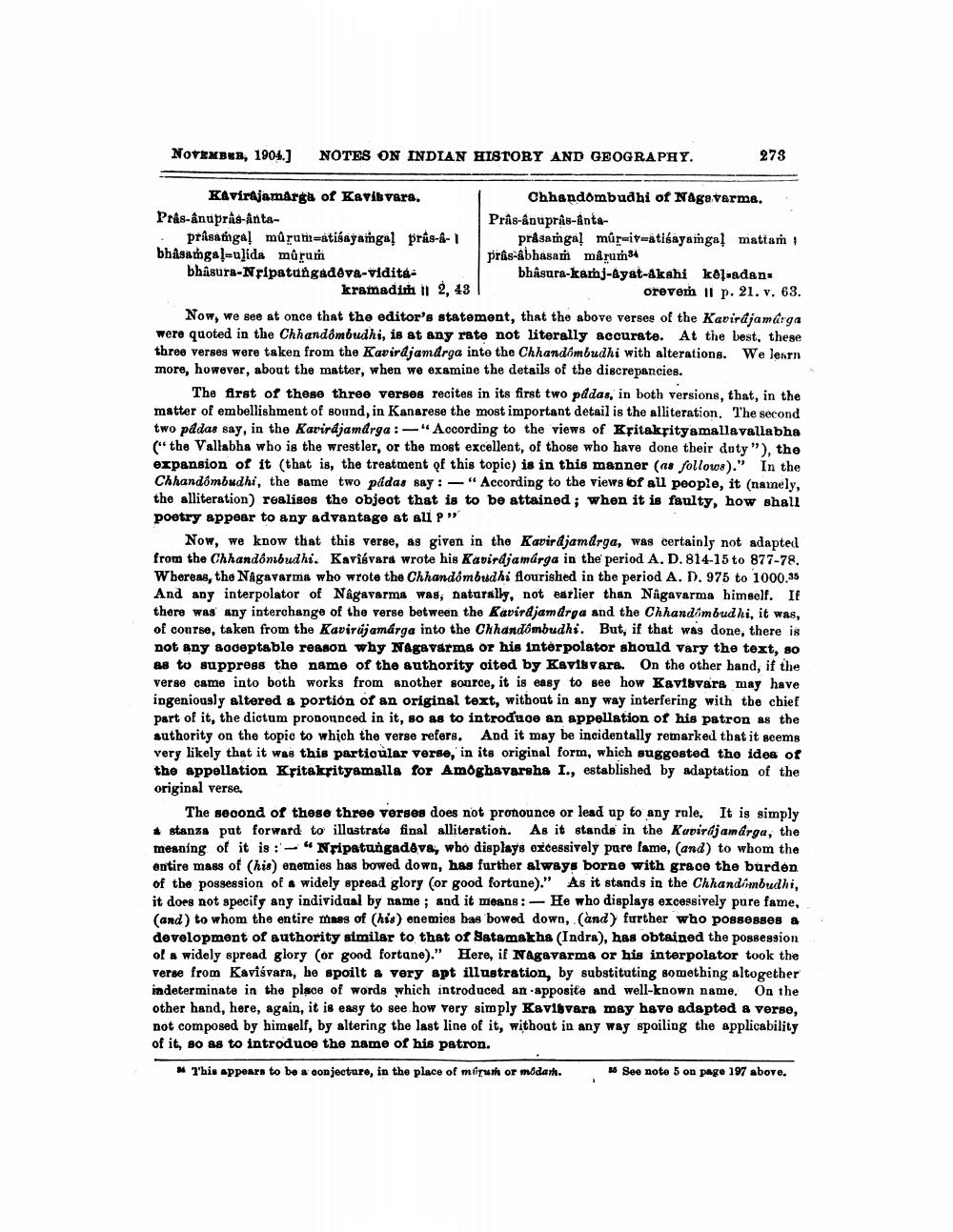________________
NOVEMBRA, 1904.)
NOTES ON INDIAN HISTORY AND GEOGRAPHY.
273
Kavirajamarga of Kavisvara.
Chhandombudhi of Nagavarma. Prás-anuprâs-Anta
Pras-ânupras-anta• prasatinga! mûrumratiśayañga! prás--1 prasamga! mürşiv=atibayangal mattam bhasangal=ulida mûrum
pras-ábhasa mârum34 bhâsura-Nripatungadáva-vidite
bhâsura-kamj-Ayat-Akshi kolmadan kramadim 112, 43
orever Il p. 21. v. 63. Now, we see at once that the editor's statement, that the above verses of the Kavirajamarga were quoted in the Chhandômbudhi, is at any rate not literally accurate. At the best, these three verses were taken from the Kavirdjamarga inte the Chhandombudhi with alterations. We learn more, however, about the matter, when we examine the details of the discrepancies.
The first of these three verses recites in its first two pddas, in both versions, that, in the matter of embellishment of sound, in Kanarese the most important detail is the alliteration. The second two pádas say, in the Karirdjamdrga :-"According to the views of Kritaksityamallavallabha ("the Vallabha who is the wrestler, or the most excellent, of those who have done their duty"), the expansion of it (that is, the treatment of this topic) is in this manner (as follow8)." In the Chhandômbudhi, the same two pádas say: - "According to the views of all people, it (namely, the alliteration) realises the objeot that is to be attained; when it is faulty, how shall poetry appear to any advantage at all p"
Now, we know that this verse, as given in the Karir djamdrga, was certainly not adapted from the Chhandônbudhi. Kavisvara wrote his Kadirdjamárga in the period A. D. 814-15 to 877-78. Whereas, the Någavarma who wrote the Chhandombudhi flourished in the period A. D. 975 to 1000.35 And any interpolator of Nagavarma was; naturally, not earlier than Nagavarma himself. If there was any interchange of the verse between the Kavirdjam drga and the Chhandombud hi, it was, of course, taken from the Kavirajamárga into the Chhandômbudhi. But, if that was done, there is not any acceptable reason why Nagavarma or his interpolator should vary the text, so 88 to suppress the name of the authority oited by Kavisvara. On the other hand, if the verse came into both works from another source, it is easy to see how Kavisvara may have ingeniously altered & portion of an original text, without in any way interfering with the chief part of it, the dictum pronounced in it, so as to introduce an appellation of his patron as the authority on the topic to which the verse refers. And it may be incidentally remarked that it seems very likely that it was this partioular verge, in its original form, which suggested the idea of the appellation Kritakrityamalla for Amoghavarsha I., established by adaptation of the original verse.
The second of these three verses does not pronounce or lead up to any role. It is simply stanza put forward to illastrate final alliteration. As it stands in the Kapirajamdrga, the meaning of it is :-“ Nripatungadave, who displays excessively pare fame, (and) to whom the entire mass of (his) enemies has bowed down, has further always borne with grace the burden of the possession of a widely spread glory (or good fortune)." As it stands in the Chhandombudhi, it does not specify any individual by name ; and it means:- He who displays excessively pure fame, (and) to whom the entire mass of (his) enemies bas bowed down, (and) further who possesses & development of authority similar to that of Satamakha (Indra), has obtained the possession of a widely spread glory (or good fortune)." Here, if Nagevarme or his interpolator took the verse from Kavisvara, he spoilt & very apt illustration, by substituting something altogether indeterminate in the place of words which introduced an apposite and well-known name. On the other hand, here, again, it is easy to see how very simply Kavisvara may have adapted a verse, not composed by himself, by altering the last line of it, without in any way spoiling the applicability of it, so as to introduce the name of his patron.
This appears to be a gonjecture, in the place of mirum or modan.
See note 5 on page 197 abovo.




